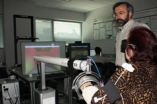(Press-News.org) HYDROPOWER -- Fishy behavior . . .
Proposals to install hydrokinetic turbines – like underwater windmills – in rivers across the U.S. are prompting questions about the environmental impacts of this new hydropower energy source. In response, researchers at Oak Ridge National Laboratory are investigating how electromagnetic fields generated by the turbines could affect the behavior of freshwater fauna such as snails, clams, minnows and sturgeon. "We know that certain marine organisms like sharks are sensitive to electromagnetic fields, but almost nothing is known about freshwater organisms," ORNL's Glenn Cada said. The scientists say the research will help companies and regulators make decisions and form policies about hydrokinetic installations. [Contact: Morgan McCorkle, (865) 574-7308; mccorkleml@ornl.gov]
BIOLOGY -- Database a likely lifesaver . . .
Highly effective anti-virus programs for computers are providing the inspiration for a system to protect people from deadly genetically engineered biological bugs. While the National Cyber Security Division's US-CERT provides cyber security updates and tools to safeguard computers within federal agencies, industry, state and local governments and the public, no such program exists to protect the public from harmful biological threats. That could change, however, with BioSITES, the vision of Department of Energy Oak Ridge National Laboratory researchers Robert Cottingham and Tom Brettin. "Through CERT, we have a giant knowledge base that provides a national infrastructure to protect our computers from viruses," Brettin said. "In the same mold, we see BioSITES as a system to defend against potentially lethal bio-engineered microorganisms." [Contact: Ron Walli, (865) 576-0226; wallira@ornl.gov]
SENSORS -- Setting standards . . .
By testing radiation detection equipment and helping establish national and international standards, a team of Oak Ridge National Laboratory researchers protects the people who keep the nation safe. The Graduated Rad/Nuc Detector Evaluation and Reporting program fulfills a Congressional mandate to set capability standards and establish a test and evaluation program for radiation and nuclear detectors. "The basic idea is to ensure that we identify the functional limitations of radiological and nuclear detection equipment," said Pete Chiaro, who leads numerous international and American National Standards Institute standards committees. "A key goal is to make sure our soldiers and front line officers have what they need to keep them and us safe." [Contact: Ron Walli, (865) 576-0226; wallira@ornl.gov]
FUSION -- Intense neutron detectives . . .
What does it take to withstand the conditions of ITER, the world's largest fusion energy reactor? Neutron scattering is one way to find out. The Spallation Neutron Source at Oak Ridge National Laboratory offers fusion researchers with the U.S. ITER Project Office at ORNL, the Japanese Atomic Energy Agency and the ITER Organization a unique resource for improving the performance of superconducting cables. In the ITER design, toroidal magnetic confinement fusion relies on superconducting cable that must endure extreme magnetic fields and electromagnetic forces. SNS has the most intense neutron beams of any pulsed neutron source in the world, and the facility's VULCAN engineering diffractometer can handle large samples like the ITER cable. "VULCAN provides unique information on actual volume fractions and residual strains in constituent materials that is very valuable for characterizing the true state of superconducting cables," said Wayne Reiersen of the U.S. ITER Project Office. [Contact: Deborah Counce, (865) 574-0644; councedm@ornl.gov]
###
To arrange for an interview with a researcher, please contact the Communications and External Relations staff member identified at the end of each tip. For more information on ORNL and its research and development activities, please refer to one of our Media Contacts. If you have a general media-related question or comment, you can send it to news@ornl.gov.
Story tips from the Department of Energy's Oak Ridge National Laboratory February 2011
2011-02-09
ELSE PRESS RELEASES FROM THIS DATE:
March 2011 Geology highlights
2011-02-09
Boulder, CO, USA - Highlights of articles set for the March issue of GEOLOGY (posted online on 3-4 February 2011) are provided below. Topics include marine ferromanganese crusts as potential mineral resources; CO2 emissions from volcanic lakes; deformation of the seemingly dormant Damavand volcano, northern Iran; a finding that relic chitin-protein complex plays critical role in the preservation of organic arthropod fossils; description and mapping of the 19 March 2008 Halema'uma'u crater eruption on Kilauea; and a study of the Cilaos deep-sea fan beneath La Reunion Island ...
Quality varies in social networking websites for diabetics
2011-02-09
Boston, Mass. – Nearly one-half of U.S. adults who use the Internet participate in social networks. While these increasingly include health-focused networks, not much is known about their quality and safety. In one of the first formal studies of social networking websites targeting patients, researchers in the Children's Hospital Boston Informatics Program performed an in-depth evaluation of ten diabetes websites.
Their audit found large variations in quality and safety across sites, with room for improvement across the board. As reported online January 24 in the Journal ...
Dutasteride not a cost-effective way to prevent prostate cancer in some men
2011-02-09
DALLAS – Feb. 8, 2011 – The popular drug dutasteride may not be a cost-effective way to prevent prostate cancer in men who are at elevated risk of developing the disease, according to findings by a UT Southwestern Medical Center researcher.
In a study available in the January issue of Cancer Prevention Research, investigators found that the medication, at an annual cost of $1,400, is impractical when compared to the marginal impact on survival and quality of life in at-risk groups. The drug is indicated for the treatment of enlarged prostates but also is widely prescribed ...
MU researcher says the next large central US earthquake may not be in New Madrid
2011-02-09
COLUMBIA, Mo. – This December marks the bicentennial of the New Madrid earthquakes of 1811-12, which are the biggest earthquakes known to have occurred in the central U.S.
Now, based on the earthquake record in China, a University of Missouri researcher says that mid-continent earthquakes tend to move among fault systems, so the next big earthquake in the central U.S. may actually occur someplace else other than along the New Madrid faults.
Mian Liu, professor of geological sciences in the College of Arts and Science at MU, examined records from China, where earthquakes ...
The international digital divide
2011-02-09
The developed nations must invest in information and communications technologies (ICT) in the developing world not only the close the so-called digital divide but to encourage sustainable economic development and to create new markets for international commerce.
Many observers have suggested that the gap between those with access to ICT and those without it is growing. But, all world citizens should have the opportunity to benefit from open access to ICT. The benefits are obvious to those given access in terms of education and opportunity, but ICT availability in developing ...
Study: Consumers value safer food more than current analyses suggest
2011-02-09
COLUMBUS, Ohio – Government regulators could more realistically assess the value of improving food safety if they considered the fact that consumers typically want to avoid getting sick – even if it means they have to pay a little extra for safer food, researchers say.
In the world of food regulation, cost-benefit analyses are a primary tool for assessing the societal benefits of mandating more stringent – and more expensive – processing practices. In most cases, regulators determine a dollar value associated with pursuing new rules by estimating how many illnesses and ...
Thoughts of hopes, opportunities keep people from clinging to failing investments
2011-02-09
It's a common problem in the business world—throwing good money after bad. People cling to bad investments, hoping that more time, effort, and money will rescue their turkey of a project. A new study published in Psychological Science, a journal of the Association for Psychological Science, finds that changing people's mindsets can make them more likely to abandon a failing investment.
"These situations happen all the time," says Assistant Professor Daniel C. Molden, of Northwestern University, who conducted the study with his graduate student Chin Ming Hui. "They happen ...
Study shows delayed-enhancement MRI may predict, prevent strokes
2011-02-09
SALT LAKE CITY, Feb. 8, 2011 – Researchers at the University of Utah's Comprehensive Arrhythmia and Research Management (CARMA) Center have found that delayed-enhancement magnetic resonance imaging (DE-MRI) holds promise for predicting the risks of strokes, the third leading cause of death in the U.S. Their latest study on a novel application of this technology appears in the Feb. 15 issue of the Journal of the American College of Cardiology. (http://content.onlinejacc.org/cgi/content/abstract/57/7/831)
The study included 387 patients who were treated for atrial fibrillation ...
Brief diversions vastly improve focus, researchers find
2011-02-09
CHAMPAIGN, Ill. — A new study in the journal Cognition overturns a decades-old theory about the nature of attention and demonstrates that even brief diversions from a task can dramatically improve one's ability to focus on that task for prolonged periods.
The study zeroes in on a phenomenon known to anyone who's ever had trouble doing the same task for a long time: After a while, you begin to lose your focus and your performance on the task declines.
Some researchers believe that this "vigilance decrement," as they describe it, is the result of a drop in one's "attentional ...
JAMA features NJIT biomedical engineer helping stroke patients
2011-02-09
The Journal of the American Medical Society ("Medical News & Perspectives", Jan. 19, 2011) featured the research of NJIT Associate Professor Sergei Adamovich, a biomedical engineer. Adamovich and his research partners, physical therapists Alma Merians, PhD, PT, and Eugene Tunik, PhD, PT, at the University of Medicine and Dentistry of New Jersey, have developed innovative robotic and virtual reality-based video game therapies to help stroke patients regain use of hands and arms.
JAMA reported that the efforts of this team are making headway. Twenty-four patients who ...

